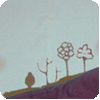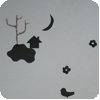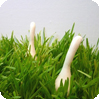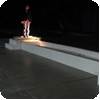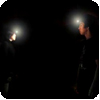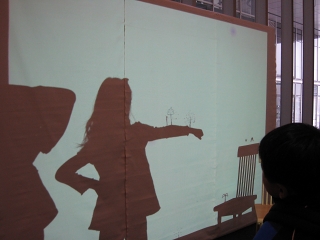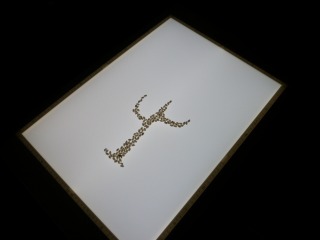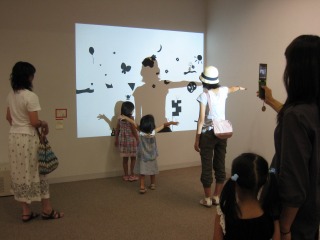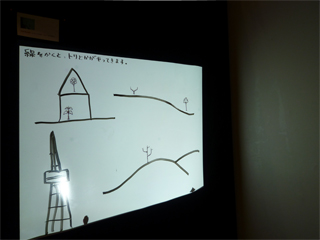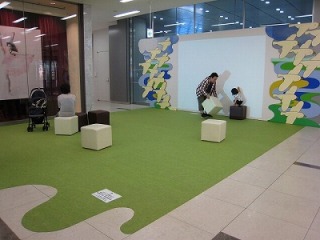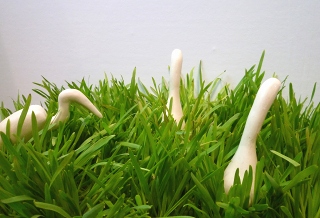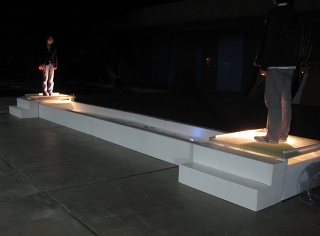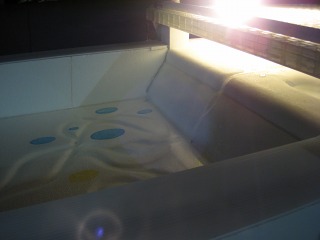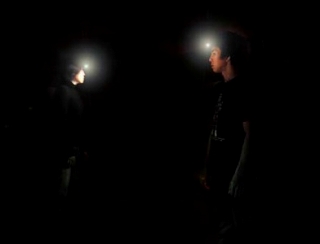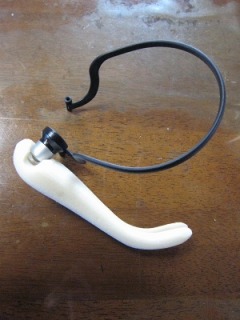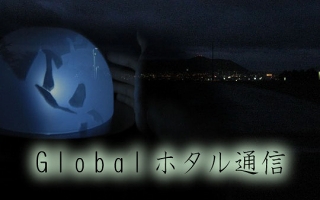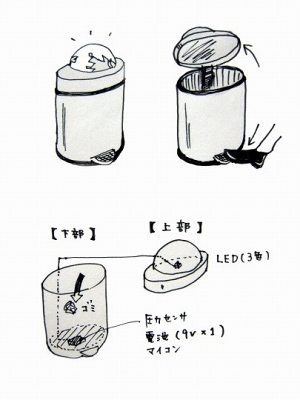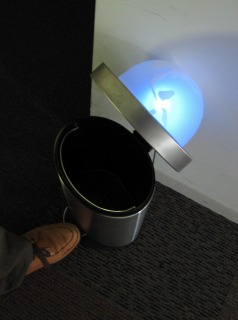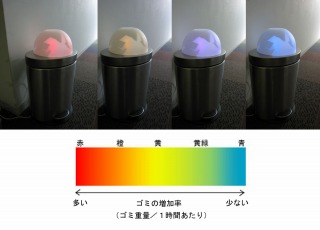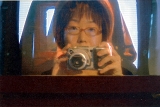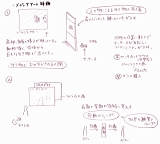Works
The Shadow Series
This is the series of the interactive animation using a shadow.
It is the interactive animation work which Ayumi Kizuka + Kazuki Matsumoto made.
An announcement was made from 2007 and three were released by the present
as an improved version: torikage, Mebuki, Kageto.
1. torikage (2007) |
||
|
Torikage is An Interactive Animation by Ayumi KIZUKA + Kazuki MTSUMOTO. When we stand by a wall, everyone gets a shadow. Torikage can make appears some birds on the shadow. I made Torikage when I was lived in Hokkaido, Japan. Then, I made this animation with using the rice that made in Hokkaido named "Hoshino-Yume", which mean a respect for gifts from the land. Well, it's ran by the image processing algorithm that we made. It uses one screen, projector, PC with Web camera. Especially, always children enjoy playing. Relative Links
|
|
|
▲top
|
|
2. Mebuki (2010) |
||
|
Mebuki is analogous to torikage. It's an interactive animation by Ayumi KIZUKA + Kazuki MTSUMOTO too. When we stand by a wall, everyone gets a shadow. Mebuki can make appears some birds and buds on the shadow. "Mebuki" means "sprouting out" or "the appearance of the floral stem" in Japanese. I made Mebuki when I was lived in Okayama, Japan. Then, I made this animation with using the black rice that made in Okayama named "Shikoku-Mai", which mean a respect for gifts from the land. Well, It's using the improved Torikage's image processing algorithm. It needs one screen, projector, PC(any OS's OK) with Web camera. Especially, from children to elderly people enjoy playing. Relative Links
|
|
|
▲top
|
|
3. Kageto (2011) |
||
|
As a result of exhibiting torikage and Mebuki, the opportunity to change how to play by the place to exhibit increased. Then, we extended the method of play and named Kageto. Kageto means "A Shadow and..." in Japanese. Shadow and Paper-cuttingIn 2011, it needed to exhibit in the Ishibashi art museum (Fukuoka, JAPAN) using the large wall. The exhibition was for children. I chose a Paper-cutting as the theme. I got a child to cut black drawing paper by himself and stuck it on a wall. Then, a bird flies to it and a plant springs up. A younger child was able to start a triangle and a circle easily using scissors. An older child was able to cut the heart and a star dexterously more finely. An adult cut complicated figures, such as human, a telegraph pole, or a mountain, and had stuck on the wall. The adult and the child was able to communicate through the work made mutually. They considered the various ways of playing. Shadow and DrawingIn 2011, the bird lover gathered and exhibited in design fiesta Vol.33 (we called the bird festival). Because the exhibition booth was narrow, we thought new method of exhibiting for using a projector. Moreover, it has expected that many persons on the hall visited liking and good at drawing a picture. The portable white board was stuck on the wall so that the person who came to see could participate. I got them to draw a picture there by pen. If a projector was projected there, a tree would spring up from the picture and a bird flied to it. They were able to look at the picture which one drew in the fresh feeling. Hakata's original versionIn 2011, the plan of exhibiting an art work was all over the town between Hakata Station and Tenjin Station. It's an event called Machinaka Art Gallery FUKUOKA. As part of it, I exhibited in the open space between the shopping building and a wicket in JR Hakata Station . You may be unable to understand, I set two special animation. It's the tree in which a spiced cod roe grows, and the tree in which ramen noodles grow. It is the Hakata original version. This appeared twice in a day for 12:00 to 5 minutes, and for 17:00 to 5 minutes. Of course, animation was made using Fukuoka rice (I used glutinous rice then). Relative Links
|
|
|
▲top
|
|
Sagi (2011) |
||
|
Sagi is a sculpture of an egret. "Sagi" means "Egret" bird in Japanese. I inspired the egret in green rice paddies when I was lived in Okayama, Japan. Then, I was absolutely-fascinated with the contrast between white and green. How cute! they stay still nevertheless they're found by anyone. Well, I recreate in clay. You can put a stick into the Sagi. Second, put it in a grass kitty or a grow wild on a vacant lot. Third, bring back to memory for countryside. The Sagi version-1 for sale at Design Festa Vol.33 is 3-inches of height and waterproof. During the next twelve months, I'll make it by ceramic. Especially, I hope it go back to Nature in your daily life. Sagi is close to the Nature. Relative Links
|
|
|
▲top
|
|
Omoi-numa (2008) |
||
|
Omoi-numa is an Interactive Stage and Pool by Ayumi KIZUKA and Satoshi SHIBUYA. "Omoi-numa" means "thoughtfully in puddle" in Japanese. We compares a moment that people-to-people link each other to the appearance water-to-water becomes one mass. When 2 people ride in each stage and emotionally accessible, then the water overflows under the each foot, and it access. Second, when the water's full capacity, the water-drops clink into the point between two people. And it twinkles in the point of each gazes' center. At that moment ther eyes met, reaffirmed connections each other. In the work Omoi-numa, we used "emotionally accessible" to resemble "the frequency similar to the each pitch of physical move". So we used the pyroelectric sensor and the IR sensor. The system counts their physical move in real time. If these pitches're similar, the water pump under their stage run and the water roll between two people. As the water incurrent, some small point lights indicate in the pool gradually. When the water was full, the small blue light indicated at the center of the pool. In conjunction with that, the water-drop pump run at the ceiling. We controled that with using a microcomputer "Gainer". Omoi-numa stage is 6-meter-long separately-placed (the total length's 8-meter-long). It is the distance that a little far and within earshot each other. Actually when people experienced Omoi-numa in the atelier at Okayama-Prefectural University, I thought it was just the right size. But it may be too long to exhibit and transport. I'll make another version that is small sized within a table. Relative Links
|
|
|
▲top
|
|
Hotaru-Tsushin (2006) |
||
|
Hotaru-Tsushin is a communication tool with using one's breathing data. "Hotaru-Tsushin" means "communication like a Firefly's" in Japanese. It measured user's breath. If the user breathed out, the light on gradually, and if the user breathe in, the light off gradually. It's very simple system. When the speed of breathe rapidly, the light's color become red. And when the speed of breathe slowly, the light's color become blue. Your breathe become rapidly when you are exciting, and vice versa when you are relax. Well, if you used Hotaru-Tsushin, you can find yourself feelings. I hope many people wear the Hotaru-Tsushin. If some breathe's pich were synchronized, the tool blink humble of white color. Then someone may find who are like him or her feeling, a good chance to communication other people. When I made a presentation in the symposium Nicograph Vol.6 Spring, a contest the Paper & Art category -Excellent Prize in the Paper Poster Session Category- in 24 Mar.2007. The Hotaru-Tsushin still has improving better than before. Relative Links
|
|
|
▲top
|
|
Global Hotaru-Tsushin (2007) |
||
|
The Global Hotaru-Tsushin is an interactive garbage box for helping the earth environment. "Hotaru-Tsushin" means "communication like a Firefly's" in Japanese. The concept of this product is "not to throw garbages into a trash" and lead to "not to buy unnecessary goods as possible", finally lead to "to reduce the excess energy", that's earth-friendly. Global Hotaru-Tsushin has a lighted semispherical earth model at top of the box. It measured the frequency of throwing garbages by a microcomputer "Arduino". If you throw the garbage frequently, the earth would blink quickly and the light color become red. The red light expressed anger or breathless state of the earth. And if you throw the garbage with less frequent, the earth would blink slowry and the light color become blue. The blue light expressed the earth's feeling of affection or feeling lively. As if the earth's relaxing. A continuation of the condition, the earth will express to a feeling of thankfulness for a user by twinkling when open the box. Because the system included a vibration sensor, a weight sensor and a microcomputer, it needed about 5-volt DC. I should upgrade it for eco-design, for example with using a electrical solar-powered source. The Global Hotaru-Tsushin was be awarded a second place of the Grand Prix of Eco Japan Cup 2007's category eco-design of culture in Dec.2007. And it displayed Eco Products 2007 at 13-15 Dec.2007 which was held in Tokyo Big Sight. Relative Links
|
|
|
▲top
|
|
A Injuring Mirror (2006) |
||
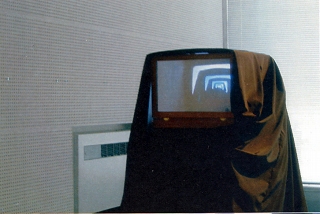 |
A Injuring Mirror is a Media Art. It makes you're able to see your back shot and front shot at the same time. It's not in familiar landscape. When you looks into it, you're looked into by own. The observer is observer. It's connected to a loop. This system used a display and a half-mirror on the front, and used a video camera on the back. So you can see a montage of images. One day, when I went out from my college, I found the dead bird which were flattened. The bird collided with a glass wall of college and concertinaed. It's not retain the bird's original features. I realized that there was the quiet death in my daily life. There was also existed many victims of living things. The human is no exception. I think there is something contradicting. One who create a physical artifact is a living thing.
|
|
|
▲top
|
|

